Submissions
Submission Preparation Checklist
As part of the submission process, authors are required to check off their submission's compliance with all of the following items, and submissions may be returned to authors that do not adhere to these guidelines.- The submission has not been previously published, nor is it being considered by another journal.
- The submission adheres to E-JournALL's Code of Ethics.
- The text adheres to the stylistic and bibliographic requirements outlined in the Author Guidelines below.
- Where available, URLs or DOI for the references have been provided.
- The submission file is in OpenOffice, Microsoft Word, or RTF document file format.
- The text is single-spaced; uses Cambria 10 point font; and all illustrations, figures, and tables are placed within the text at the appropriate points, rather than at the end.
- The article has been anonymized. It does not contain information that could reveal the identities of the author(s) to reviewers.
Special Issue - Abstract proposal
Authors submitting abstracts for special issues are advised to adhere to the following guidelines:
-
The Guest Editors (GEs) will expect titles and abstracts from invited scholars and potential non-invited authors as a confirmation of their interest in submitting an article.
-
GEs will review the abstracts in consultation with the Support Editor and aim to provide initial feedback to the authors within one week of receipt, or by the end of the month at the latest.
-
If deemed necessary, the Support Editor may choose to consult with E-JournALL editors regarding abstracts posing particular challenges.
Copyright Notice
All E-JournALL publications are distributed with Creative Commons license, Attribution 4.0 International (CC BY 4.0), https://creativecommons.org/licenses/by/4.0/
Privacy Statement
The names and email addresses entered in this journal site will be used exclusively for the stated purposes of this journal and will not be made available for any other purpose or to any other party.

